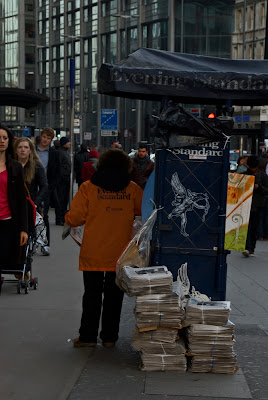The film consists of a series of static shots of sometimes startling beauty and resonance, accompanied by Scofield's ironic voiceover and an elegiac soundtrack and evokes a London which has gone forever, even though the film was made a relatively short time ago in 1994. There is a deeply melancholic and nostalgic feeling permeating the whole film, which stems from the perception of the void at the centre of modern urban life. The narrator's voice muses "For Londoners, London is obscured, too thinly spread, too private for anyone to know, its social life invisible, its government abolished.... the true identity of London is in its absence." Iain Sinclair describes this absence as a 'necropolis of fretful ghosts, a labyrinth of quotations: not so much the ruin of a great city as the surgical removal of its soul.' (1)
There is a quietness and stillness about the film which is mesmerising. One of the most memorable sequences is a short scene showing a pair of young children playing in the dappled sunlight of Arnold Circus in Shoreditch, East London, the sounds of the children's cries ringing out against the intermittent distant traffic noise and rustling of pigeons' wings - an island of calm and tranquillity.
Still from London by Patrick Keiller
Still from London by Patrick Keiller
Still from London by Patrick Keiller
Arnold Circus is part of the Boundary Estate, the first example of social housing development built by the London County Council in 1897 to replace one of London's most notorious slum areas - The Old Nichol Street Rookery - and immortalised in Arthur Morrison's fictionalised account of the life of a slum child A Child of the Jago. The rubble from the slum clearance was used to make a mound in the centre of the Circus, site of the bandstand which is still in existence. In the film Robinson considers the estate to be 'a fragment of a golden age, a utopia.'
Little changed, the area still feels like a peaceful backwater that resonates with a sense of the past although only a stone's throw from the galleries, shops and cafes of rapidly changing Shoreditch. Walking around there recently it was relatively easy to visualise the scenes from the film and I understood what attracted Keiller to the place.....
Keiller's London documents a bygone era but the concerns of the film seem particularly relevant to the current political, economic and social situation. Possibly a case of what goes around, comes around......
(1) Sinclair, Iain: London: Necropolis of fretful ghosts, essay in the booklet accompanying the DVD London and Robinson in Space



















